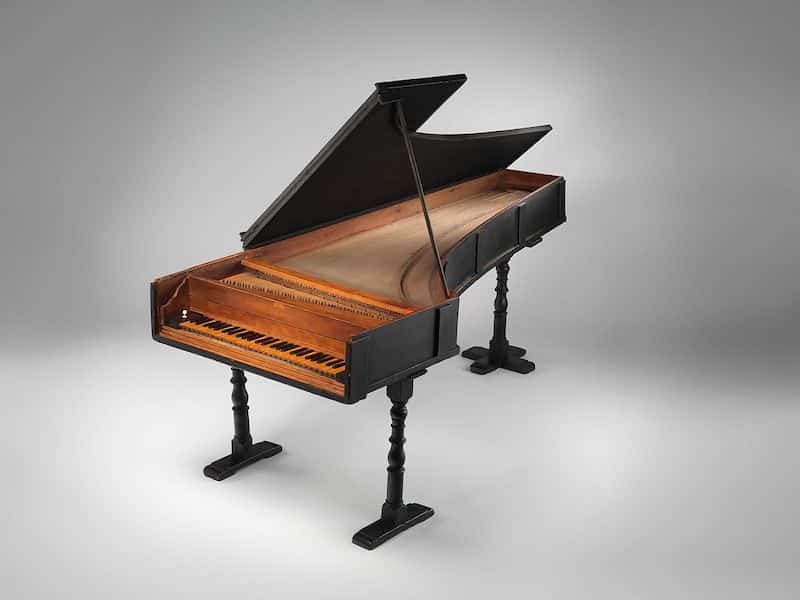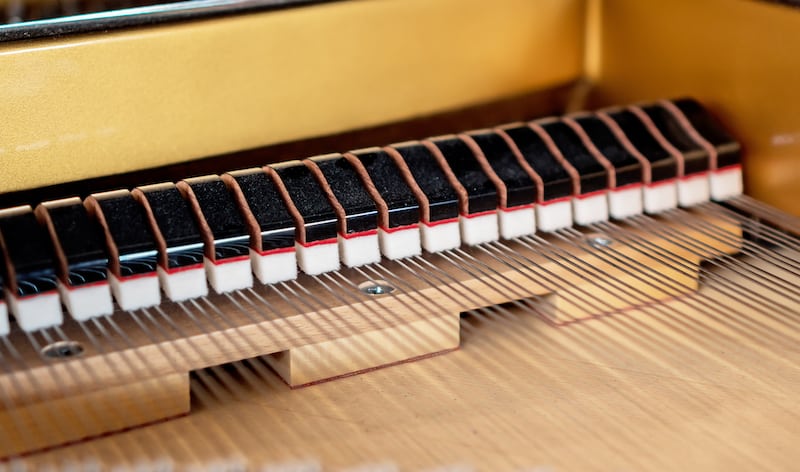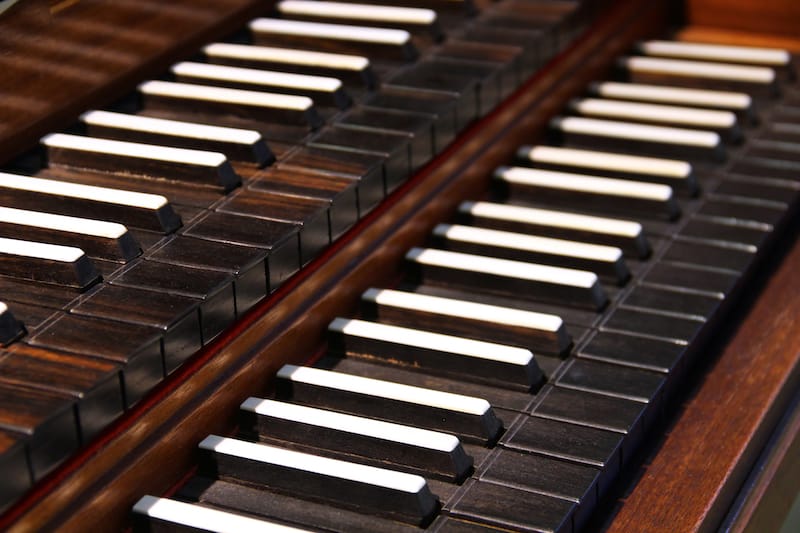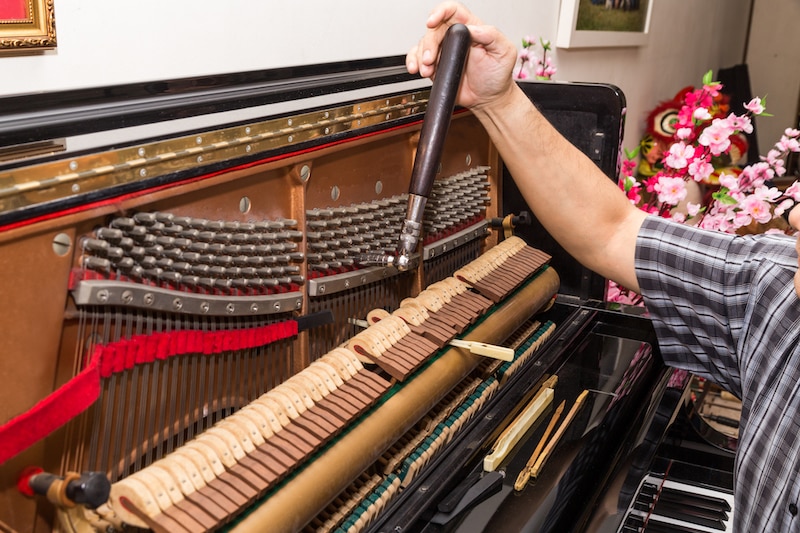The piano’s ancestry traces back to several instruments, including the harpsichord and the monochord. When you press the white and black keys, a small hammer strikes the internal metal strings producing the sound.
Having evolved over the centuries, the piano continues to enrich music performances and compositions to this day. We’ll share 16 interesting facts about the piano that would entertain every music lover in this post.
1. The Piano is Classified as a String and Percussion Instrument
According to its structure and ancestry, the piano descends mainly from the monochord.
This is an ancient string musical instrument that was mentioned in Sumerian writings and was reinvented by Pythagoras in the sixth century BC and Guido of Arezzo around 1000 CE.
But when looking at the parts of a piano, you’ll see that the sound is made by vibrating strings that are hit by a hammer.
For this reason, when categorizing it into a family of instruments, we can put it in the string family as it’s very similar to a harp or a lyre.
But, because the piano’s strings are hit by a hammer, it can also be classified as a percussion instrument and it’s generally considered to be in both families..
2. The First Piano Was Made in Italy in 1709

In 1709, harpsichord maker Bartolomeo Cristofori improved his instrument and invented a new musical instrument called the gravicèmbalo col piano e forte.
This name translates to a ‘harpsichord with soft and loud notes‘.
The name was later shortened to the pianoforte and then to just the piano which is the name that stuck.
3. Pianos Used to Have Ivory Keys

What material piano keys are made from depends on when they were made.
Modern pianos since the 1970s tend to be made from plastic but ones from before that tend to be made from ebony and ivory.
Before they were banned in the 20th century, pianos used to have ivory keys, where the ivory only covered the top layer of the keys.
However, the ivory was prone to chipping and turned yellow after a few years.
You can see in the image above the line across the keys which is a sign that the keys are made of ivory.
4. Each String in the Piano Holds Lots of Tension

A piano contains between 220 and 230 steel strings, and each one of them holds around 168 tons of tension.
This means that an average piano holds between 18 and 20 tons of tension.
However, some of the most professional pianos can hold up to 30 tons of tension.
5. Not All Pianos Have the Same Number of Keys
A standard piano has 88 keys, but some digital pianos have a fewer number of keys.
Some older acoustic models don’t also hold 88 keys. In modern pianos, it’s not uncommon to find pianos that have 92 or 102 keys.
These instruments hold more keys added to the bass area.
In 2018, Stuart and Sons introduced the world’s first 108 keys piano!
6. The Keys of the Pianos Weren’t Always the Same

Nobody actually knows why the piano keys were white and black, but there are two theories to explain this fact.
The first one is that the original keys were covered in ivory and ebony, and these are their natural colors.
The second one is that the difference in keys managed to allow pianists to know which keys they’re playing. However, this wasn’t always the case.
In the 18th century, the colors were actually reversed.
As a matter of fact, this was the case with all other keyboard instruments used during this period.
7. A Piano Offers The Largest Notes Range of all Instruments
In a typical 88 keys piano, there are 7 octaves, compared to the four octaves found on a guitar and violin.
However, in larger pianos, the number can reach up to 9 octaves.
8. A Grand Piano has a Larger Range than an Upright Piano
A grand piano offers wider dynamics than an upright piano and has the ability to add more subtle expression to notes.
It also has a higher ability of note repetition because the hammers return quicker to their resting place.
As a result, key repetitions as fast as 14 times per second are possible with a grand piano, while they can only be as fast as 7 times per second with an upright piano.
When it comes to their looks, an upright piano has vertical strung strings that allow the instrument to be set up in more compact spaces.
Upright pianos are also more affordable than grand pianos; however, they’re less visually appealing.
9. The Pedals Change the Tones of the Piano

Traditionally a piano has three pedals to change the articulation of the piano.
The damper or sustain pedal prolongs the sound when a key is hit, the sostenuto pedal acts as a selective damper, and the una corda or soft pedal shifts the hammers so that they only hit one of each note’s strings.
However, the middle pedal isn’t included in older pianos. In an upright piano, there are usually two pedals. These are also used for practice purposes.
10. Pianos Need to be Tuned

A new piano needs to be tuned between 3 and 4 times a year, as this will give the new strings a chance to settle.
After a few years, it would be enough to tune the piano twice or once a year.
If the piano is moved to a new location, it should be left in the new environment for a week until it settles.
After that, the piano should be moved because most moving trucks expose the piano to high levels of humidity that cause the internal parts to loosen and eventually affect the sound of the piano.
11. Rebuilding a Piano is Quite Common
Different factors determine the value of a piano. Mass-produced pianos depreciate with time, and rebuilding an older piano can actually increase its value.
In this case, the piano’s frame is maintained, and the internal parts are replaced, so it can become like a brand new instrument.
However, some pianos appreciate with time, and this is common with popular brands like Yamaha and Steinway.
Limited edition and custom-made instruments also hold their value and become even more valuable with time.
12. The Crystal Piano by Heintzman is the Most Expensive Piano in the World
For lots of years, pianos were so expensive that they were only found in the palaces of royalty and houses of aristocrats.
This was mainly because of the craftsmanship needed to produce a single piano.
However, today the title of the most expensive piano belongs to the Crystal Piano built by Heintzman & Co., a Canadian-based manufacturer.
This piano was played once to promote the Beijing Olympics Games before it was retired.
It holds a value of $3,220,000.
13. There Are Several Differences Between a Piano and a Harpsichord
The main difference between a piano and a harpsichord is related to how they work.
In a piano, the strings are struck with a hammer, while in the harpsichord, they’re plucked, so it’s classified as a string instrument.
The harpsichord is much older than a piano and was mainly used by Baroque composers like Rameau, Bach, and Handel.
The piano was a signature of the Classical and Romantic periods, playing the main role in the compositions of Beethoven and Chopin.
Although both instruments have keys, they’re usually made of wood on a harpsichord but can be made of wood, ivory, or plastic on a piano.
The harpsichord also has a reverse keyboard, where sharps are white, and the naturals are black.
While playing the piano, you have more control over the volume and strength of the sound because pressing the key for long allows the sound to persist and resonate, but such control isn’t available to a harpsichord player.
14. The Piano Used to Play Itself
At the end of the 19th century and into the 20th, ‘player pianos’ were incredibly popular.
These mechanical pianos were able to play themselves reading piano rolls that composers and performers would write to be able to be read and played by these player pianos.
These were great ways for people to be able to have music in their home before electricity allowed people to be able to listen to the radio or gramophones.
15. The Piano Played a Key Role in Several Movies
In addition to being one of the most widely used musical instruments, the piano actually played a key role in some of the most successful movies.
In movies like The Pianist, the piano was used to symbolize the loss of civilization due to war, and the protagonist used it in the end to save his life.
For his role, Adrian Brody actually practiced learning to play the piano.
In another movie, The Piano, it was used by the main character to express her feelings because she couldn’t speak, as she was mute by choice.
It represented her past and what she wanted to break free from.
16. It Takes Between 10 and 15 Years to Learn to Play the Piano
In order to master playing the piano, you need to practice for several hours every day, and it takes about 10 to 15 years until you’ve mastered it.
However, if you’re not planning to play it professionally, you can definitely play the piano for your own enjoyment after three to five years or even less of continuous practice.
Summing Up Piano Facts
The piano is one of the most popular musical instruments and has played a crucial role in musical compositions since the 1700s.
Today, it still holds its place among music lovers and is worth all the practice, even though it’s not an easy instrument to play.
Nevertheless, all piano lovers agree that it’s worth all the effort.

